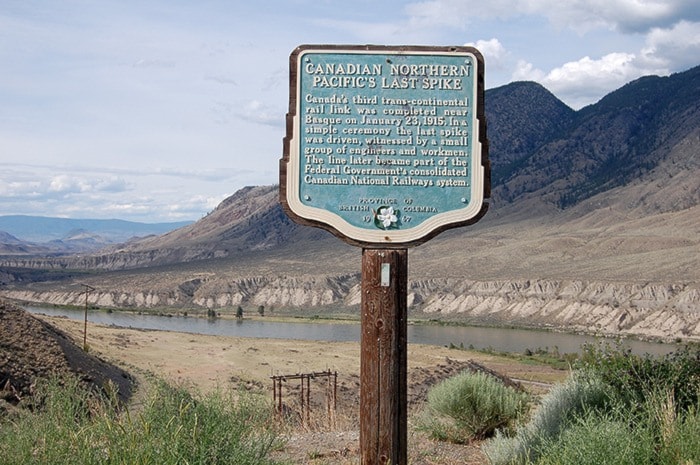On a doubtless cold and grey January day in 1915 (a “great quantity of snow” had fallen recently, according to The Journal), a group of dignitaries gathered just south of Ashcroft to witness the pounding of the last spike of the Canadian Northern Pacific Railway at Basque. The notables were probably outnumbered by workmen, who had been toiling to complete the rail line, started in late 1910. While an iconic photograph of the pounding of the last spike on the CP line in 1885 exists, there are no known pictures of what transpired at Basque; we cannot even be sure where, precisely, the last spike was hammered into place.
It’s a rather depressing end to a venture which had started so hopefully, when William Mackenzie and Donald Mann (after whom Port Mann is named) decided to expand the Canadian Northern Railway beyond the prairies, pushing west from Edmonton to the Pacific and east into Ontario in order to try to get a share of the lucrative business over which CP had a virtual monopoly. The Grand Trunk Railway was also expanding westward to Prince Rupert at the same time, and there was undoubtedly some unofficial competition between the two ventures.
Due to the fact that the name “Canadian Northern Railway” was already registered in B.C. to another consortium, Mackenzie and Mann incorporated the “Canadian Northern Pacific Railway Company” here, to avoid litigation. Two crews of workers began making their way towards each other from Port Mann and Edmonton, and it was planned that the project would be completed within four years.
For much of its route the CNPR paralleled the CP track, which presented some daunting challenges. As the first railway line through the Rockies and the interior, CP had the advantage - in areas where there were a limited number of options when it came to laying railway tracks - of picking the best (or the least worst) route. This meant that the CNPR would, in places such as the Fraser Canyon, have to get creative in order to avoid geographic pitfalls the CP had already gone around, while at the same time finding a viable route not already occupied by CP tracks. Nowhere was this more apparent than at Cisco, near Boston Bar, where the CP had been forced to switch from one side of the river to another. The CNPR had to do the same thing; only their bridge had to span not only the Fraser River, but the existing CP trestle.
The impact of the new railway was keenly anticipated by residents of Ashcroft. The CNPR line would be across the river from the town, which at that time occupied the downtown area bounded by Railway Avenue and the Thompson River. What is now called North Ashcroft was largely unsettled, and there was real concern that the coming of the CNPR would result in a rival town springing up on the other side of the river around the track and station (think of Boston Bar and North Bend, as a comparable instance). As we know, that eventuality did not come to pass; but it was certainly on the minds of Aschroftonians a century ago, as The Journal reported that “CNR workmen are busy unloading material for their station and section house across the river.”
The CNPR line through the province continued apace, even though it was plagued by difficulties. It’s little surprise when major infrastructure projects come in late and over budget, but the CNPR faced something no one could have foreseen, back in 1910: the start of World War I in August 1914. In an instant, demand for the raw materials the railway needed to complete its line increased, and since companies could not magic more steel, iron, and wood into being, the railway had to pay higher rates for these items. It also faced a loss of workers, as thousands of men signed up to join the Canadian Expeditionary Force, leaving their former employers scrambling for replacements.
Another difficulty was that the Fraser Canyon section of the CNPR had to be built by hand due to the difficulty of getting machinery in to the area. No such problem existed in the flat terrain around Ashcroft, and on Jan. 23 1915 The Journal reported that “The C.P.N. tracklayer with its comet-like tail of about a hundred men has come and gone.” The machine was capable of laying a length of track in less than four minutes, with material passed through it by a crew in front and then laid by the men at the back. A similar machine was heading east, with the two crews set to meet just south of Ashcroft. The Journal reported that many residents equipped with cameras came out to record the progress of the tracklayer; but none of their photographs exist.
The meeting of the two sets of tracklayers ended up being at Basque, a “little station on the main line of the Canadian Northern Pacific Railway where the last spike in Canada’s new steel belt was driven on Saturday [Jan. 23, 1915]. There at noon many sweating workmen plied their hammers in one last tremendous dash to complete the line on time. They did it.”
They may have done it; but the Canadian Northern had, during the course of its expansion, fatally over-extended itself. In 1918, unable to pay the interest on its loans, it was taken over by the Canadian government. The same fate befell the Grand Trunk Railway in 1920; a fact that became a plot point in season three of Downton Abbey, when the Earl of Grantham revealed he had lost a considerable amount of money because of heavy investment in the Grand Trunk. Both railways were incorporated into the national railway system: the Canadian National (CN) Railway we know today.
Barbara Roden
